Introduction

The Shindo Muso Ryu Jodo Association Incorporated is a nonprofit, educational and cultural
organisation dedicated to providing quality training and instruction for the transmission of the
Japanese Koryu (classical martial art) Shindo Muso Ryu Jodo.
What You Will learn through Jodo
Our Sydney dojos provide opportunities for all adults to learn Jodo.
SELF AWARENESS. Jodo teaches you self discipline, respect and alertness. You will sharpen your
reflexes, learn how
to co-ordinate your whole body to move with speed and agility. You will develop your confidence and
ability to rely on yourself.
SELF DEFENCE. Your main objective in Jodo is not to get hit. You will learn how to manoeuvre your way
around
the attack of an oncoming sword or Jo in order to keep yourself out of danger. You will also learn
vital target
points and how to strike your attacker whilst escaping at the same time. Your peripheral vision will
develop as
well as widen and you will have the ability to see an oncoming attack before your opponent even
begins to move.
SAFETY FIRST. Jodo is a martial art originally conceived in part to kill. A hit with a Jo (wooden
stick)
or a bokken (wooden sword) can have very serious consequences. Jodo is mostly practiced with a
partner
without any protective gear so any injury inflicted through carelessness will leave you without a
training partner (among other things). You will be taught how to respect each other's safety and
your responsibilities with managing a weapon.
PARTNER AND TEAM WORKING SKILLS. You will learn how to work together with a partner and develop trust
as well as wariness.
You will learn how to communicate with each other through timing and body language. Being sincere in
your training
is also being respectful to the other person as you enable them to train properly and develop at a
faster pace.
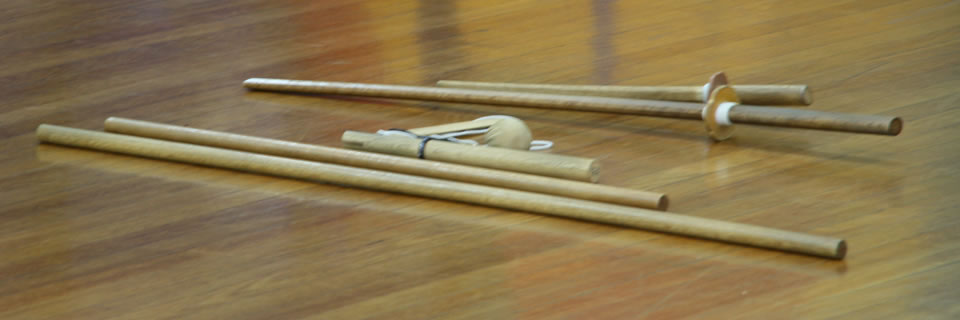
Weapons You Will Train With
The jo is a stick made of hardwood oak and is about 30cm longer than the average sword.
Its cylindrical shape makes it difficult to break. This resembles the Japanese field plowing
tools that the workers would utilize as self defence from an attacking samurai sword. The typical
length is 128cm, a diameter of 2.4cm - 2.6cm, and a weight of 550g.
The bokken is a Japanese wooden training sword. Legendary samurai Musashi was known to kill opponents
with a mere wooden sword.
In higher grades of training you will be introduced to other weapons such as the Kodachi (short
sword),
Tanjo (short wooden stick), Kusarigama (a sickle with ball and chain), and the Jutte (truncheon).
Jodo is practised with 12 basic techniques known as the 'kihon' and partner duelling enforces the
basics through a series of 'kata' (choreographed sequences) that become more complicated as you
progress through your levels of training.
What to Wear
When you first start Jodo you may train in any exercise clothes that are comfortable and provide ease
of movement. Jodo is trained barefoot however shoes can be worn outside for protection.
As you become more proficient there is an optional training uniform that can be bought.
It consists of the 'gi' (martial arts top that wraps at the front), the hakama (samuari pants)
and obi (belt for holding the sword).
Where to buy your equipment and clothing
While you may be able to find suitable equipment in Australia in our experience it's been better to
order directly rom Japan.
Here are two websites from which our members have received quality equipment and clothing:
Seido
Tozando
Please check with your instructor before making any purchase as the available equipment can vary
subtly from that which we normally use.
Shindo Muso Ryu Jodo

History of Shindo Muso Ryu Jo:
Shindo Muso Ryu Jo is said to be the oldest style in Japan for using a stick (jo) in combat.
It was founded in the early 17th century by Muso Gonnosuke Katsuyoshi, an exponent of Tenshinsho-den
Katori Shindo Ryu. Shindo Muso Ryu oral tradition maintains that Gonnosuke once fought Miyamoto
Musashi, one of the most famous swordsmen of the time, with a staff (bo) in a training match and
was defeated by Musashi's cross-block (jujidome) technique.
According to legend, Gonnosuke was dissatisfied with this outcome and retired to Mt. Homan,
in what is now Fukuoka Prefecture, in Kyushu, where he engaged in a series of religious austerities,
all the while contemplating the reasons for his defeat. Finally, he received "divine" inspiration
about a new method of using a staff-like weapon, making it shorter (128cm) and thinner (24mm)
for more rapid manipulation. He devised a number of techniques for this new weapon, which he
called a stick (jo) (as opposed to staff or bo), that included the use of the thrust of a spear,
strike of a sword and staff and sweep of a naginata. Factual documents of the style (ryu) are quite
rare.
It is said that there is a record at Tsukuba Shrine, in Ibaragi Prefecture, that reports that
Gonnosuke was able to defeat Musashi in a rematch.
In the mid-1970s Paul Maloney Sensei returned from Japan and setup a group to study Shindo Muso Ryu
Jodo in Sydney.
Today this group is known as the Shindo Muso Ryu Jodo Association Incorporated.
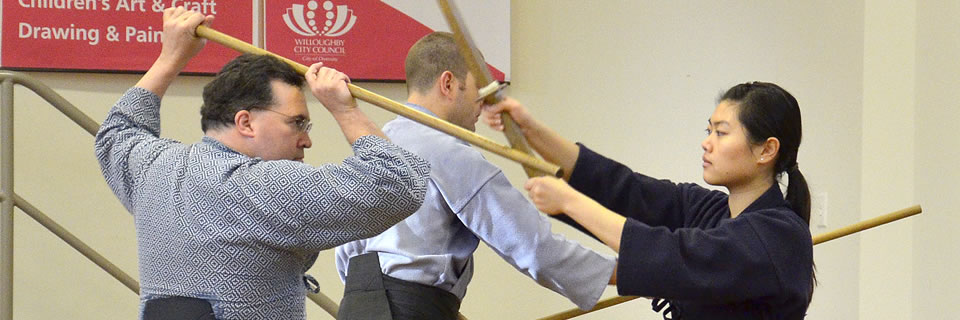
Traditional curriculum
Training is conducted in formal two person pre-arranged kata. In Shindo Muso Ryu Jodo there are a
total of
64 techniques which are divided into a number of series, each with a different character.
Training is systematic and develops the exponent's technical skills and psychological abilities,
from body movement and weapons handling to the proper use of targeting, distancing and timing, and
intense mental or spiritual training, all originally aimed to enable the exponent to successfully
use
the weapon in mortal combat.
Exponents begin their study of jo by learning a series of twelve basic techniques (kihon waza), which
contain
all the essential movements of the style. They then proceed through different series of techniques
of stick
versus sword(s): omote, chudan, ran-ai, kage, samidare, gohon-no-midare, and okuden.
A final series, the gokui hiden (also called go-muso-no-jo), consists of techniques that are taught
only to
exponents who have received a Menkyo Kaiden, the highest level in the system.
Also included in the curriculum of the Shindo Muso Ryu Jodo are twelve techniques of the
swordsmanship
system called Kasumi Shinto Ryu kenjutsu. The first eight techniques are long sword versus long
sword,
followed by four techniques that are long sword versus short sword.
There are five levels of recognition in Shindo Muso Ryu Jodo. They are the Okuiri-sho, Shomokuroku,
Gomokuroku,
Menkyo and Menkyo Kaiden. Holders of Menkyo Kaiden are the only people qualified to issue Mokuroku
and Menkyo
in Shindo Muso Ryu Jodo.
In addition to Shindo Muso Ryu Jodo and Kasumi Shinto Ryu Kenjutsu, a number of separate arts are
taught at various
points in an exponent's training. These are considered assimilated arts, and include:
- Uchida Ryu Tanjo jutsu (short stick)
- Isshin Ryu Kusarigama jutsu (ball, chain and sickle)
- Ikkaku Ryu Jutte jutsu (truncheon)
- Ittatsu Ryu Hojo jutsu (Rope tying and restraining)
Text adapted from Meik and Diane Skoss' "Field Guide to the Japanese
Classical Martial
Arts" in Sword & Spirit:Classical Warrior Traditions of Japan, volume two. ©1999 Koryu
Books.
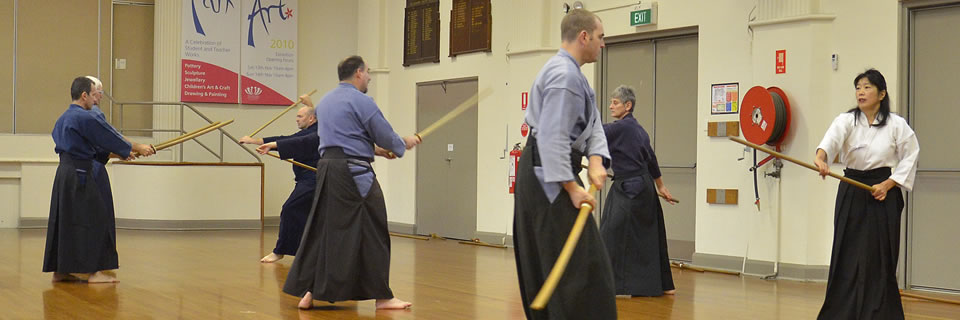
Counting in Japanese
Within a class moves are called out and counted in Japanese. This is to ensure you are able to
participate in any
seminar or class around the world if you choose to take your Jodo with you abroad.
- 0 zero 零
- 1 ichi 一
- 2 ni 二
- 3 san 三
- 4 shi/yon 四
- 5 go 五
- 6 roku 六
- 7 shichi 七
- 8 hachi 八
- 9 kyuu 九
- 10 juu 十
Kendo
For those desiring training in Japanese swordsmanship with a robust sporting outlet, Kendo is highly
recommended.
The Sydney Kendo Club (SKC) is the
longest running Kendo club in Australia.
SKC are located in the Willoughby Park Center and operate on Wednesdays and Saturdays.
References
Counting in Japanese
An introduction to Jodo
The things you should note while
practicing Jodo
An explanation of the Uchidachi
and Shidachi roles in Jodo
Koryu Bujutsu Introduction
Sword & Spirit Intro: A Coconut
Palm in Missouri
Sighting the Grizzly
What is a Ryu?
Transmission & Succession in the
Classical Arts
Classical Martial Arts in the West:
Problems in Transmission
The Meaning of the Martial Arts:
Some Reflections From Along the Way
Some Thoughts on Learning Koryu in
the West
The Meaning of Martial Arts
Training: A Conversation with Sawada Hanae
The website of the European Jodo
Federation
The website of the Pan American Jo
Federation
A recommended reading list
for beginners and others interested in traditional Japanese martial arts (Koryu)
Terminology
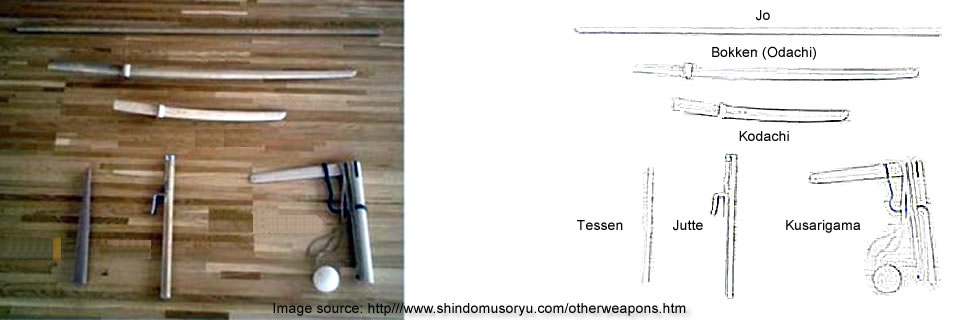
The names of Jodo's Kihon, Kata and assimilated weaponry
Kihon (basic techniques)
The Kihon or basic techiques are fundamental to good jo practice. These are the foundations for the
Jo Kata.
- Honte Uchi
- Gyakute Uchi
- Hikiotoshi Uchi
- Kaeshi Tsuki
- Gyakute Tsuki
- Maki Otoshi
- Kuritsuke
- Kurihanashi
- Taiatari
- Tsukihazushi Uchi
- Dobarai Uchi
- Taihazushi Uchi
Kata
Omote
Omote is the first series of 12 kata in Shindo Muso Ryu. The emphasis is on teaching correct
technique,
and developing an understanding of Ma-ai (distance), Ri-ai (timing), and Zanshin.
- Tachi Otoshi
- Tsuba Wari
- Tsuki Zue
- Hissage
- Sakan
- Ukan
- Kasumi
- Monomi
- Kasa no Shita
- Ichirei
- Neya no Uchi
- Hoso Michi
Supplementary Kata
These kata were developed by Shimizu Sensei from the Tanjo techniques and are often taught with the
Omote kata.
- Suigetsu
- Sharmen
Chudan
Chudan is the intermediate series of 12 Kata following Omote.
- Ichi Riki
- Oshi Zume
- Midare Dome
- Ushiro Zue (Zen and Go)
- Taisha
- Kengome
- Kiri kake (or Kikkake
- Shin Shin
- Rai Uchi
- Yokogiri Dome
- Harai Dome
- Seigan
Ranai
Ranai translates as "Disorder to Harmony" and combines Omote and Chudan techniques.
- Odachi (long sword) no Ranai
- Kodachi (short sword) no Ranai
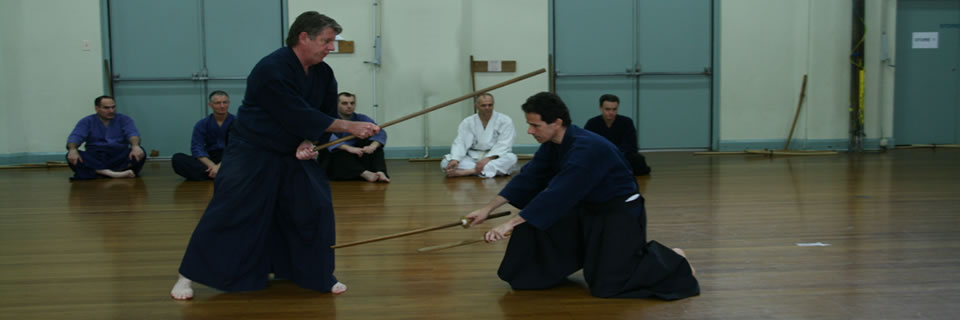
Kage
Kage is intermediate training and it is a series of 12 Kata of whose names are identical with the
Omote Kata.
Samidare
Samidare is a series of 6 Kata taught to advanced students emphasizing training the mind.
- Ichimonji
- Jumonji
- Kodachi otoshi
- Mijin Zen
- Mijin Go
- Gan Tsubushi
Gohon no Midare
Gohon no Midare is a series of 5 Kata added by Shimizu Sensei around 1939.
They are a synthesis of Omote, Chudan, Ran-Ai and Kage Kata.
- Tachiotoshi no Midare
- Sakan no Midare
- Kengome no Midare
- Kasumi no Midare
- Shamen no Midare
Okuden
Okuden is a series of 12 kata taught to advanced students.
- Sengachi
- Tsuki Dashi
- Uchi Tsuke
- Kote Dome
- Hikisute
- Kote Garami
- Jutte
- Mikaeri
- Aun
- Uchi Wake
- Suigetsu
- Sayu Dome
Hiden Gokui
The Hiden Gokui are a series of five Kata, and are "secret forms" taught only to those who are Menkyo
Kaiden.
- Yamiuchi
- Yumemakura
- Murakumo
- Inazuma
- Dobo

assimilated weaponry
Kasumi Shinto Ryu Kenjutsu
Odachi (long sword)
- Ai Suri (Sa)
- Ai Suri (Yu)
- Ju
- Chi Barai
- Sarin
- Uke Kaeshi
- Nitto Ai - uchidachi armed with both odachi and kodachi
- Suri Komi
Kodachi (short sword)
- Inchu
- Uke Nagashi
- Miuke Dome
- Tsuki Dashi
Uchida Ryu Tanjojutsu
- Kote Uchi (Sa)
- Kote Uchi (Yu)
- Sutemi
- Kuri tsuke
- Ushiro Zue
- Suigetsu (Sa)
- Suigetsu (Yu)
- Shamen (Sa)
- Shamen (Yu)
- Kobushi Kudaki
- Sune Kudaki
- Irimi
Ikkaku Ryu Jutte
The modern Ikkaku Ryu system fields 24 training-forms (kata) divided between 2 series called Omote
and Ura.
Both series have identically named kata.
- Uken
- Zanken
- Saken
- Keageken
- Ichiranken
- Irimiken
- Ippuken
- Meateken
- Utoken
- Gorinken
- Isseiken
- Kasumiken
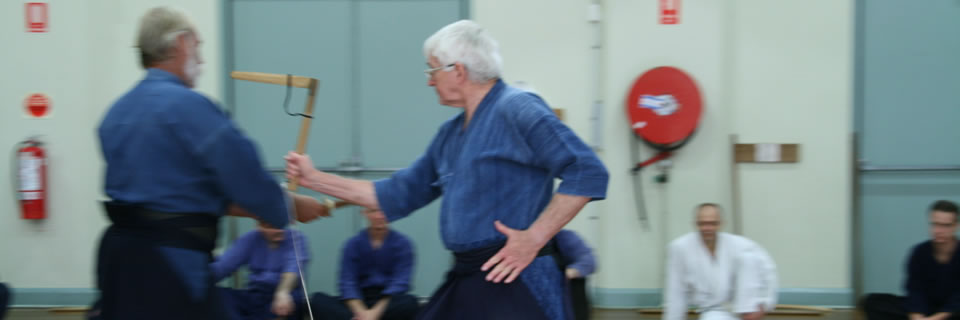
Isshin Ryu Kusarigama
A total of 30 kata divided into 3 series: Omote; Ura, and Okuden
Omote and Ura
- Ishiki
- Soemi
- Hagaeshi
- Mugan
- Jûmonji
- Furikomi (zen)
- Furikomi (go)
- Isô no Nami
- Tatsumi no Maki
- Midokorozume
- Ukibune
- Sodegarami
Okuden
- Mae
- Ushiro
- Hidari
- Migi
- Yariai (jo)
- Yariai (ge)
Seitei
These 12 Jodo kata were selected by a committee headed by Shimizu Sensei from the Omote and Chudan
kata for training by the Zen Nihon Kendo Renmei (Japanese Kendo Federation).
- Tsuki Zue
- Suigetsu
- Hissage
- Shamen
- Sakan
- Monomi
- Kasumi
- Tachiotoshi
- Rai Uchi
- Seigan
- Midare Dome
- Ranai
Class Usage of Japanese
During a class some directions are typically given in Japanese.
Following are some common directions and their meanings in English:
| Direction |
Meaning |
| Seiretsu |
Line up |
| Mokusō |
Clear the mind |
| Yame |
Stop |
| Shōmen ni rei |
Bow to the front - when no calligraphy or kamidana (shrine) is present |
| Shinzen ni rei |
Bow to the shinzen (calligraphy scroll / kamidana) |
| Sensei ni rei |
Bow to the teacher(s) |
| Otagai ni rei |
Bow to each other |
| Onegai shimasu |
Please (be of assistance to me) |
| Arigatō gozaimashita |
Thank you very much |
And following are directions given during Kihon practice:
| Direction |
Meaning |
| Sōgo ni rei |
Bow to each other (when doing kihon sōtai) |
| 1. Honte ni kamae |
Into honte position (honte no kamae) |
| Honte uchi yōi |
Ready honte strike |
| Hajime |
Begin |
| Yame |
Stop |
| Moto e |
Back to original position |
| Maware migi / Ichi kōtai |
Turn right (for solo) / Change positions (for paired) |
| 2. Gyakute ni kamae |
Into gyakute position (gyakute no kamae) |
| Gyakute uchi yōi |
Ready gyakute strike |
| Hajime |
Begin |
| Yame |
Stop |
| Moto e |
Back to original position |
| Maware migi / Ichi kōtai |
Turn right (for solo) / Change positions (for paired) |
| 3. Hiki otoshi uchi yōi |
Ready hiki otoshi strike |
| Hajime |
Begin |
| Yame |
Stop |
| Moto e |
Back to original position |
| Maware migi / Ichi kōtai |
Turn right (for solo) / Change positions (for paired) |
| 4. Honte ni kamae |
Into honte position |
| Kaeshi tsuki yōi |
Ready kaeshi tsuki |
| Hajime |
Begin |
| Yame |
Stop |
| Moto e |
Back to original position |
| Maware migi / Ichi kōtai |
Turn right (for solo) / Change positions (for paired) |
| 5. Honte ni kamae |
Into honte position |
| Gyakute tsuki yōi |
Ready gyakute tsuki |
| Hajme |
Begin |
| Yame |
Stop |
| Moto e |
Back to original position |
| Maware migi / Ichi kōtai |
Turn right (for solo) / Change positions (for paired) |
| 6. Honte ni kamae |
Into honte position |
| Maki otoshi yōi |
Ready maki otoshi |
| Hajime |
Begin |
| Yame |
Stop |
| Moto e |
Back to original position |
| Maware migi / Ichi kōtai |
Turn right (for solo) / Change positions (for paired) |
| 7. Kuritsuke yōi |
Ready kuritsuke |
| Hajime |
Begin |
| Yame |
Stop |
| Maware migi / Ichi kōtai |
Turn right (for solo) / Change positions (for paired) |
| 8. Kuri hanashi yōi |
Ready kuri hanashi |
| Hajime |
Begin |
| Yame |
Stop |
| Moto e |
Back to original position |
| Maware migi / Ichi kōtai |
Turn right (for solo) / Change positions (for paired) |
| 9. Tai atari yōi |
Ready tai atari |
| Hajime |
Begin |
| Yame |
Stop |
| Maware migi / Ichi kōtai |
Turn right (for solo) / Change positions (for paired) |
| 10). Tsuki hazushi uchi yōi |
Ready tsuki hasushi |
| Hajime |
Begin |
| Yame |
Stop |
| Moto e |
Back to original position |
| Maware migi / Ichi kōtai |
Turn right (for solo) / Change positions (for paired) |
| 11. Honte ni kamae |
Into honte position |
| Dōbarai uchi hajime |
Begin dobarai strike |
| Yame |
Stop |
| Sonomama |
Stay in place |
| 12. Taihazushi uchi hajime |
Begin taihazushi strike |
| Yame |
Stop |
| Mae e dete |
Return to front |
| Hidari honte ni kamae |
Into left honte position |
| Hidari taihazushi uchi hajime |
Begin left taihazushi strike |
| Yame |
Stop |
| Moto e |
Back to original position |
| If paired kihon |
|
| Tachi wo osame |
Sword return |
| Shi uchi kōtai |
Change weapons (for paired kihon) |
| End of kihon (solo / paired) |
| Tachi wo osame |
Sword return |
| Sōgo ni rei |
Bow to each other (for kihon sōtai) |
| Kihon (sōtai / tandoku renshū) owari |
(Paired / solo) kihon finish |
| Rei |
Bow |
For more information refer to this
Wikipedia entry.
Contact & Dojo
Sydney training classes are generally led by instructors holding traditional Menkyo Kaiden licenses
with over 30 years
of Jodo experience as well as having senior Dan grading from the International Jodo Federation.
Initially we request that you watch a class to see if this is what you want to learn. By all
means at the end of that class, feel free to ask questions of the instructor and students to get a
better picture of our art and our school.
When you start, we would also suggest you give yourself three months to try it out properly -
many of the movements can feel counter intuitive and will take time to grasp.
Also, we regularly hold 8-week long beginners' courses.
Please contact us for more details.
Dojo
本部 Honbu
Saturday 7.45am to 9.45am
Willoughby:
Willoughby Community Centre Hall
Cnr Warrane Rd and McLelland Streets
Willoughby
Sydney NSW 2068
Chief Instructor: Sensei Paul Maloney
We acknowledge the kind assistance of Willoughby City Council for the concession we receive on
facility hire.
Tuesday 6:30 pm - 8:30 pm
North Sydney:
Police Citizens Youth Club
224-230 Falcon Street
North Sydney
Sydney NSW 2060
Instructor: Simon Genev
Wednesday 6:30 pm - 8:30 pm
Boronia Park:
Uniting Church Hall
93a Pittwater Road
Boronia Park
Sydney NSW 2111
Instructor: Andrew Poulos
Fees
We are a "not for profit" organisation.
All the monies we collect go towards paying the various expenses (such as hall rent) we have
throughout the year.
No one, including instructors, in our association receive any renumeration.
- Payments are all to be made via EFT.
Cash can no longer be accepted.
- The membership year is from July 1st to June 30th of the following year.
Please note that our fees are subject to change without prior notice.
Annual Membership/Insurance Fee
- $85 (applicable to all members)
- Payable July 1 - the beginning of the membership year
- A pro rata annual insurance fee of $45 is payable by members starting in the second half of the
financial year.
Schedule of Training Fees
- Quarterly:
$300 per 3 months
Payable on the first week of the quarter starting July, October, January, and April. Unlimited classes.
- No concessionary rates are available at this time.
- Monthly:
$100
Payable on the first week of the month. Unlimited classes.
- Casual Coupon Book:
$105
Any 5 classes - valid for 1 year (the Annual Membership/Insurance fee is in addition to the cost of books).
Multiple books can be purchased.
From time to time seminars are organised.
These allow us to share knowledge and ideas that will, at times, challenge us and help us to grow in our understanding.
They are usually open to all and require additional payment to cover the costs involved.
News
Our beginner's course has started but new beginners may still join at any time.
All classes are back for 2024. We hope everyone had a good break.








